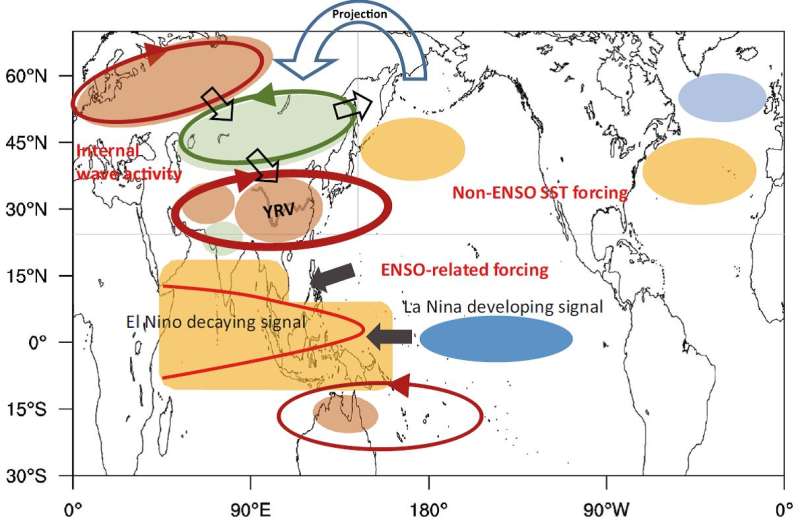Researchers study heat waves over the Yangtze River valley

Under global warming, East China is experiencing more heat waves with increasing intensity. The strongest heat wave over the Yangtze River valley (YRV) since 1951 occurred in 2013, and severely affected the economy and the health of the population. Therefore, clarifying the main factors responsible for heat wave variability is important to improving seasonal-to-annual predictions.
Recently, Dr. Xiaolong Chen and Prof. Tianjun Zhou from the Chinese Academy of Sciences investigated the mechanism of sea surface temperature (SST) forcing and atmospheric internal variability and their relative contributions to interannual variability of heat waves in the YRV. They found that SST forcing can explain about two-thirds of heat wave variability and the other one-third comes from atmospheric internal variability during 1979-2008. Interestingly, for the SST forcing, one-third is from anomalies independent from the well-known El Niño-Southern Oscillation (ENSO), though the other one-third is ENSO's contribution. All these factors cause heat waves over the YRV by moving the western North Pacific Subtropical High northward, extending it westward and intensifying the anticyclone.
"El Niño decaying followed by La Niña developing in summer could promote heat waves in the Yangtze River valley," says Chen. "The atmospheric internal variability is a circumglobal teleconnection and it shows a tripolar wave train propagating southeastwards over the Eurasia. Non-ENSO SST anomalies, warm patterns in the North Pacific and a dipolar pattern in the North Atlantic, can exert influence by projecting onto the mode of internal variability."
Their findings reveal that the internal variability promotes forcing from the extratropical SST anomalies to raise heat waves over the YRV. Further analysis shows the intensification of heat wave variability after the end of 1990s is associated with the above circumglobal teleconnection in which both the non-ENSO SST forcing and internal variability are involved. This study indicates that learning the predictability of extratropical SST, except for ENSO can potentially improve the seasonal forecast skill of heat waves in East China. The research is published in Climate Dynamics
More information: Xiaolong Chen et al, Relative contributions of external SST forcing and internal atmospheric variability to July–August heat waves over the Yangtze River valley, Climate Dynamics (2017). DOI: 10.1007/s00382-017-3871-y
Journal information: Climate Dynamics
Provided by Chinese Academy of Sciences


















